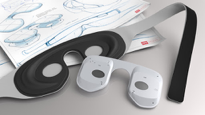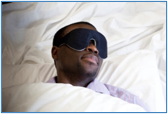Sleep mask could aid diabetic retinopathy screening
A consultant ophthalmic surgeon at Ashford and St Peter’s NHS Hospital near London has found that treating the eyes of diabetic patients with the Noctura 400 eye mask might stabilise or even improve central diabetic retinopathy changes.
During the present COVID-19 pandemic this is perceived to help diabetic patients, who find it difficult to attend retinopathy screening and eye clinic appointments.
The Noctura 400 Sleep Mask is a non-invasive and monitored home care treatment developed by NETPark firm, PolyPhotonix. The mask is programmed to administer a certain dose of light of a particular wavelength each night to maintain or improve diabetic eye changes and a patient’s vision.

Ulrich Meyer-Bothling has been conducting a UK government funded study using the Noctura 400 Sleep Mask. The study showed that 94% of all patients who correctly used the mask showed significant stabilisation and sometimes even improvement of the central diabetic maculopathy and vision with some patients seeing a reverse of their condition.
Current treatments for diabetic retinopathy are laser treatment and/or injections of anti-VEGF pharmaceuticals directly into the eye. These treatments are expensive, require substantial clinician time and need patients to attend a hospital on a regular basis.

Meyer-Bothling said: “It has been encouraging how well most of the patients in the study have responded to wearing the mask; I am hopeful, that the Noctura mask will become an additional tool in treating diabetic retinopathy.”
Diabetic eye disease is one the most common causes of sight loss in the western world.
Diabetes is the second most common underlying condition among COVID-19 patients who have died, of which 35% had the illness. Government advice is that patients with high risk conditions should not go to hospital, which means that patients with diabetes currently receiving hospital treatment for diabetic eye disease are at risk.